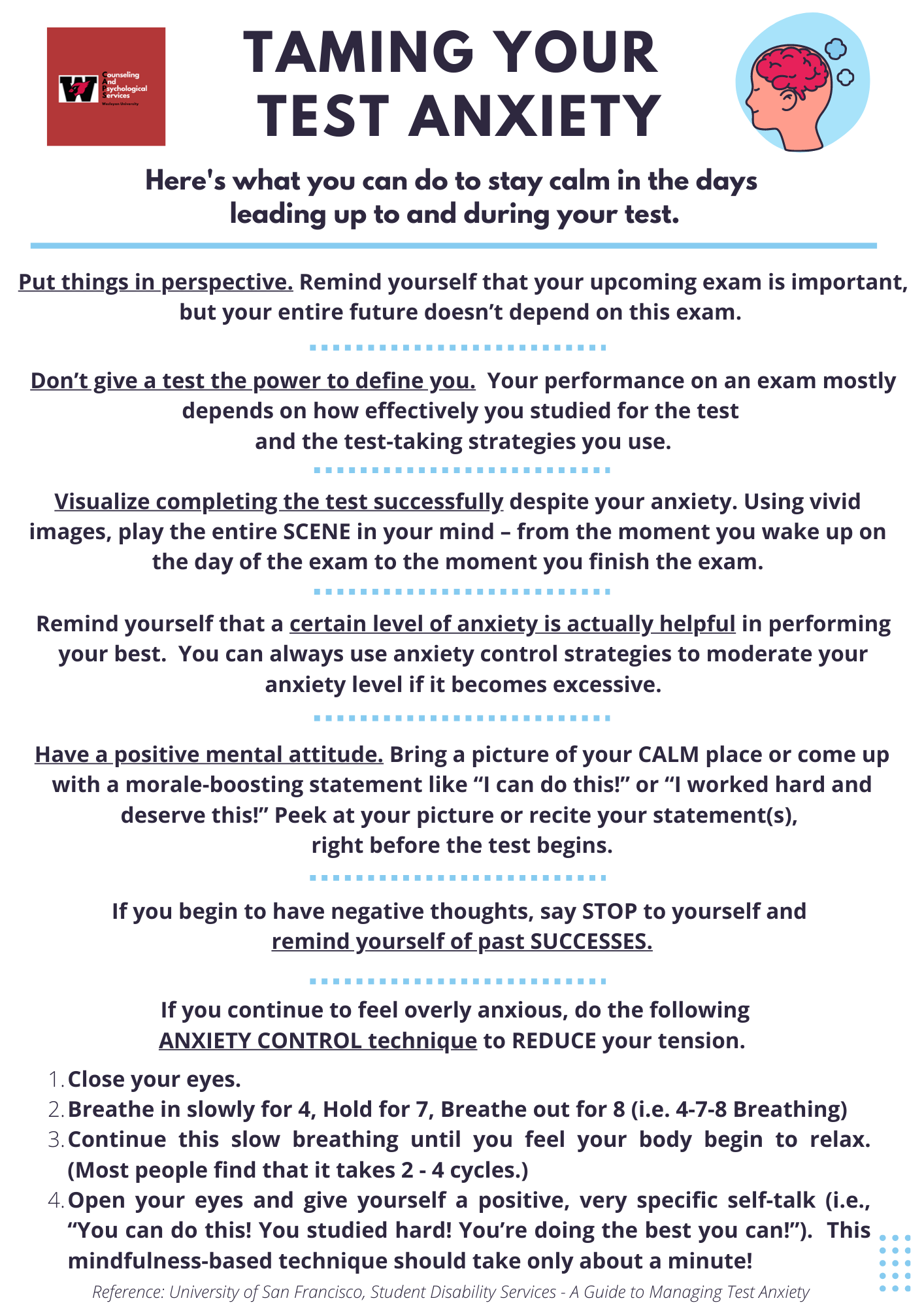Anxiety
Anxiety is the most common complaint of college students who seek counseling services. It is generally experienced as fear, worry, nervousness, or apprehension, and is normally accompanied by a variety of physical symptoms affecting the cardiovascular, gastrointestinal, and nervous systems. While anxiety is a normal emotional response to an event or situation that is novel or challenging, it becomes problematic when it interferes with one's ability to function. Many people who experience anxiety tend to avoid the stimulus that provokes it, which only makes the problem worse. The good news is that anxiety is very treatable, and our staff members are comfortable and experienced with assisting students in overcoming their problem anxiety. The Anxiety Disorders Association of America maintains a webpage for college students that is a good source of additional information
Below are some of the more common anxiety disorders experienced by college students.
- Social Phobia
This is the extreme worry/fear of being closely watched, scrutinized, criticized, and judged when in social or group settings. People with social phobia may have trouble speaking in class, attending social events, or even eating in public. They feel extreme discomfort and self-consciousness in these and similar situations. Their anxiety in these settings may be so intense that they avoid interpersonal interactions altogether, which only serves to intensify their anxiety when such experiences cannot be avoided. Social phobia is extremely common among college-aged people, and appears to occur most often in social settings and in classes that require participation.
- Panic Disorder
A person with Panic Disorder experiences recurrent episodes of intense fear that is accompanied by extremely unpleasant physical symptoms such as chest pain, racing heart, trouble breathing and dizziness. While experiencing a panic attack, people often believe they are having a heart attack or other life-threatening medical event. The experience of a panic attack is so frightening and unpleasant that people tend to associate the experience with the time, place, or event in which it occurred, and will then begin to avoid these situations. Panic Disorder with Agoraphobia is diagnosed in extreme cases in which people essentially do not leave their homes for fear of experiencing a panic attack in public.
- Obsessive Compulsive Disorder
This anxiety disorder consists of uncontrollable, unwanted thoughts called obsessions that are generally followed by repetitive behavioral rituals called compulsions. People with OCD typically engage in compulsive behavior in an attempt to get rid of their obsessive thoughts. For example, a person who is plagued by the obsessive fear that she has run over someone with her car may backtrack and check the streets over and over in an attempt to reassure herself she did not harm anyone. Compulsions do not allay obsessive fears, however, and instead often create more intense distress and worry. People with OCD recognize their thoughts and behavior are irrational, yet feel powerless to stop them. Their patterns of thought and behavior become so excessive that their functioning becomes extremely impaired.
- Post-Traumatic Stress Disorder
This anxiety disorder can develop after experiencing a trauma, an event causing extreme fear and/or helplessness that is either personally experienced or witnessed. Most people who survive traumatic events (such as natural disasters or a criminal act) will experience some anxiety symptoms for a brief time following the event. Some, however, will go on to develop PTSD. They fluctuate between continuously and intensely re-experiencing the traumatic event and assiduously avoiding all reminders of it, all the while in a state of heightened physiological arousal and emotional reactivity. PTSD was originally studied in Vietnam veterans and survivors of rape. Multiple traumas and/or traumas experienced early in life increase the likelihood a person will develop this anxiety disorder.
- Generalized Anxiety Disorder
This anxiety disorder is characterized by constant, free-floating feelings of anxiety, worry, or dread with no clear trigger or cause. People who develop this disorder typically experience accompanying physical symptoms including headaches, shakiness, irritability, difficulty with focus and concentration, and insomnia. GAD can be so severe that people lose interest in life and no longer experience joy or pleasure from any of their relationships or activities. Typically, GAD does not involve avoidance as it occurs in many other anxiety disorders, and there are usually no sudden and intense episodes of panic.
- Specific Phobia
A specific phobia is an intense, unreasonable fear of an object or situation that in reality presents little or no danger. When exposed to the feared object or situation, an individual with specific phobia experiences intense anxiety accompanied by physical symptoms such as racing heart and shakiness. As a result, he or she develops a pattern of avoidance of the object or situation, and this avoidance can significantly impair functioning. For example, situational phobias such as a fear of flying, driving over bridges, or riding in escalators or subways can lead a people to severely restrict their life choices and experiences. It is possible for one person to have two or more specific phobias.

